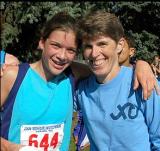Folders |
Running Issues: Fatphobia Runs RampantPublished by
Sport’s Inherent Bias Against Bigger Bodies Doesn’t Help Anyone By Elizabeth Carey for DyeStat One thing most coaches, athletes, fans and athletic staff have in common is a love for our sport. Another commonality? Fatphobia. Fatphobia is the implicit and explicit bias of individuals in bigger bodies. Fatphobia casts stigma, guilt and blame towards those deemed “overweight,” “obese” or fat. It’s rooted in racism and misogyny. It shows up in antiquated calculations of Body Mass Index (BMI) and calories. Diet culture, a set of social expectations prizing thinness, restriction, and specific body ideals, is one of fatphobia’s commercial, marketable enterprises. See: the $78 billion U.S. weight loss market in 2019, according to Market Research. Both in and beyond sport, fatphobia and diet culture assume that folks in bigger, heavier bodies are unhealthy and worse off than those in smaller, lighter bodies. Within cross country, track and field, and running, such assumptions about athletes’ bodies cling even tighter. We’ve got narrow sport- and event-specific ideals. You’ve heard (or read or seen or felt it): “Lighter is faster.” “You look like a shot putter.” “How can someone run 60 miles per week and look like that?” “You’re bulking up. You should stick to bodyweight exercises.” “What is your goal racing weight?” Despite a mounting pile of methodologically-sound evidence about how shoddy and harmful appearance- and weight-first training methodologies are, coaches — and athletes and parents and sports medicine doctors —keep pushing them. In fact, that’s what we keep finding at the heart of allegations of toxic culture in running programs, alongside other issues. Meanwhile, researchers push on, calling for cultural change. Of all the performance factors, perhaps weight and body composition/proportions seem like the simplest to adjust. But they’re not. Weight is just one physical metric of many and it fluctuates for many reasons, including the menstrual cycle. Body composition metrics and appearance betray us; we can’t actually tell how “fit” or healthy someone is by looking at them or caliper-ing folds of their skin. We can’t diagnose an eating disorder with our eyeballs. Plus, neither a specific weight nor body fat percentage nor appearance promises high performance. There’s a difference between physics and metabolism. Bodies are complex, intricate, and always in flux, even in seemingly static moments. Research has found that, contrary to much of what we hear, excess weight is not actually a much greater problem than excess thinness. Obesity is associated with risks, yes. But excess thinness is associated with higher mortality than being overweight. The very definitions of "obese" and "thin" have evolved over time, with a fat-phobic bias rooted in BMI, research, and medicine. Research shows that weight loss is rarely sustainable and diets lead to dangerous yo-yos. Social determinants of health (economic stability, health care access, neighborhood, education quality, etc.) have more influence on the shape our bodies take than anything else. That’s especially more than, say, will-power or sticking to a diet. In fact, the moralization of athletes’ bodies and food contributes to negative outcomes for athletes. The guilt and shame associated with being in a bigger body does more harm than good. Body shaming among adults fosters unhelpful, outdated ideas. Kids, adolescents, and others around body-shamers in sport pick up on those vibes quickly. For women (who face higher risks of eating disorders), and for men (who face greater stigma around disordered eating and are less likely to report it), and for nonbinary and trans folks (who face body image struggles and harassment), and for Black, Indigenous, and people of color (who are further marginalized and whose medical conditions are underdiagnosed)...OK, so for everybody who runs, jumps, or throws, focusing on weight loss is not inherently beneficial for health or performance. From countless interviews with well-versed registered dietitians, eating disorder specialists, and discussions with coaches and my own adult athletes, it seems more likely that both adolescent and adult runners, for example, aren't eating enough or consistently. Low energy availability and Relative Energy Deficiency in Sport (RED-S) threatens all athletes, not just teen girl distance runners. This issue is fraught. It’s tied up in historically faulty science and bias in medicine. In our sport, it's perpetuated by confirmation bias. But it's beyond time our community stopped assuming the fatphobic notion that weight loss equals health and performance. ### Elizabeth Carey (https://elizabethwcarey.com/) is a writer and running coach based in Seattle, Washington. Her first book, GIRLS RUNNING, co-authored with Melody Fairchild, is available at your local bookstore and here: https://shop.aer.io/GirlsRunning/p/Girls_Running_All_You_Need_to_Strive_Thrive_and_Run_Your_Best/9781948007184-9934. More news |






